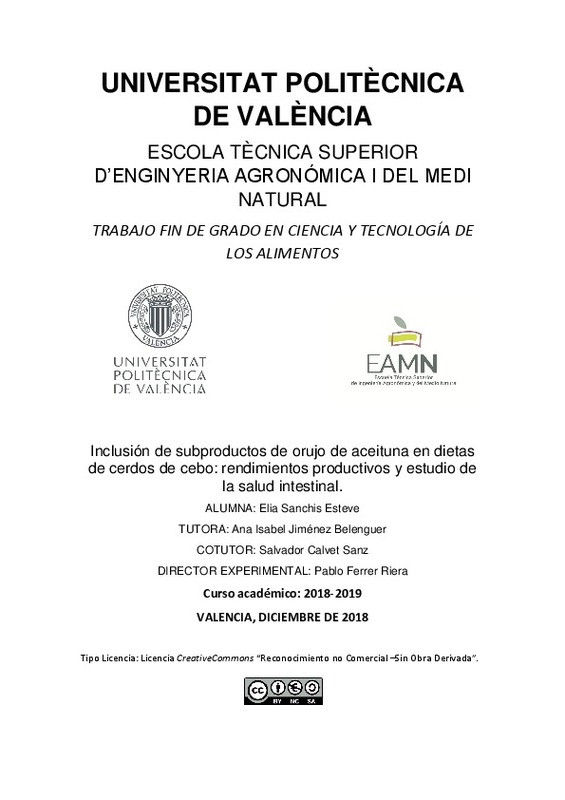|
Resumen:
|
[ES] Actualmente la carne de cerdo es la carne que más se consume a nivel mundial y se
prevé que su producción aumente en los próximos años. Por ello, la industria alimentaria
a través de sus subproductos ofrece potenciales ...[+]
[ES] Actualmente la carne de cerdo es la carne que más se consume a nivel mundial y se
prevé que su producción aumente en los próximos años. Por ello, la industria alimentaria
a través de sus subproductos ofrece potenciales materias primas alternativas para
alimentación animal, que conllevan una menor carga ambiental.
En España existen subproductos, típicamente mediterráneos como los del olivar. El
orujo de aceituna es un subproducto de la fabricación del aceite de oliva. Su
disponibilidad es bastante elevada durante todo el año, pudiéndose deshidratar, por lo
que incrementa su interés para la alimentación animal.
El objetivo principal de este trabajo es determinar los efectos de inclusión de orujo de
aceituna parcialmente desengrasado en dietas de cerdos de cebo sobre el rendimiento
del crecimiento, la salud intestinal y la calidad de la carne.
Los ensayos productivos se llevaron a cabo en la unidad experimental de cebo del
Centro de Investigación y Tecnología Animal del Instituto Valenciano de Investigaciones
Agrarias (IVIA). En el ensayo productivo se utilizaron 160 animales de 20kg de peso,
que fueron distribuidos en 32 corrales de cebo a razón de 5 animales/corral.
Posteriormente, a cada corral se le asignó un tratamiento experimental. Durante el
periodo experimental se realizaron controles quincenales de peso/animal y consumos
por corral. Una vez sacrificados los animales se tomaron medidas de pH, espesor de
grasa, color en las canales y se tomaron muestras de grasa subcutánea para su
posterior análisis de ácidos grasos.
Para el ensayo de la salud intestinal se tomaron muestras de heces de dos animales
por corral al azar. Por cada corral se homogeneizaron las dos muestras y se trató como
una. Se sembró en los distintos medios de cultivo y posteriormente se procedió a la
lectura de las colonias crecidas en cada medio.
Para el ensayo de ácidos grasos se utilizó la metodología propuesta por O’Fallon et al.,
(2007).
No se encontraron diferencias significativas entre los distintos tratamientos en cuanto al
rendimiento, la calidad de la canal y los recuentos microbiológicos. El perfil de ácidos
grasos tampoco mostró diferencias entre los distintos tratamientos, pero la
concentración de AGMI (ácidos grasos monoinsaturados) fue mayor y la de AGP(ácidos
grasos poliinsaturados) fue menor en los animales alimentados con un 12% de inclusión
de orujo de aceituna.
La falta de diferencias en los resultados obtenidos demostró que un 12% de inclusión
de orujo de aceituna se puede suministrar a los animales sin ningún efecto negativo
sobre los rendimientos, la calidad de la canal, la salud intestinal y que mejora el perfil de
AG (ácidos grasos) de la grasa subcutánea.
[-]
[EN] Pork meat is currently one of the most consumed meats worldwide and its production is
expected to increase in the years to come. That is why the food industry offers alternative
and potential raw material through ...[+]
[EN] Pork meat is currently one of the most consumed meats worldwide and its production is
expected to increase in the years to come. That is why the food industry offers alternative
and potential raw material through its sub-products for the animal feed, which imply lower
environmental burden.
In Spain there are sub-products typically Mediterranean, such as the ones derived from
the olive grove. The olive cake is a sub-product which results from the manufacturing of
olive oil. Its availability is quite high during the whole year, but it can be dehydrated, and
that is why the animal feed industry’s interest increases.
The main objective of this thesis is to determine the effects of the inclusion of partiallydegreased olive cake in diets of fattening pigs on the growth performance, the intestinal
health and the meat quality.
The productive tests were carried out in the fattening experimental unit of the Animal
Research and Technology Centre of the Valencian Institute of Agricultural Research
(IVIA). In the productive test 160 animals of 20 kg of weight were used, distributed in 32
fattening farmyards, at a rate of 5 animals per farmyard. During the experimental period,
fortnightly controls were carried out, related to weight per animal and consumption per
farmyard. Once the animals were sacrificed, several measures were adopted, regarding
Ph., fat thickness and carcass color, and also several subcutaneous fat samples were
taken in order to further analyze them in terms of fatty acids.
For the intestinal health test, stool samples from two animals were taken, chosen
randomly per farmyard. These two samples per farmyard were homogenized in order to
only work on one, which was sown in the different crops. Subsequently, the settlements
grown in each crop were analyzed.
For the fatty acids test, the methodology suggested by O’Fallon et al., (2007) was
implemented.
No relevant differences were found among the different treatments regarding
performance, carcass quality and microbiological recounts. The fatty acids profile also
showed no differences among the different treatments, but the concentration of MUFAs
(monounsaturated fatty acids) was higher and the concentration of polyunsaturated fats was
lower in the animal fed with 12% of inclusion in olive cake.
The lack of differences in the results obtained proved that 12% of olive cake may be
supplied to the animals without risk of having negative effects on performance, carcass
quality and intestinal health, and that it even enhance the profile of fatty acids of the
subcutaneous fat.
[-]
|







